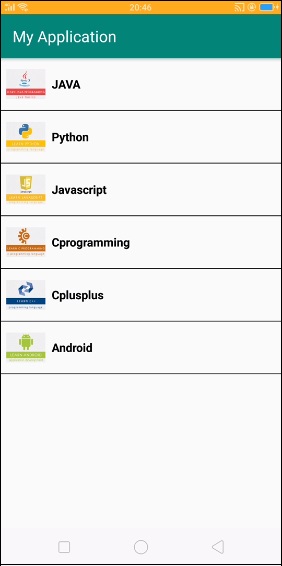如何在Android中建立自定義ListView?
在進入ListView示例之前,我們應該瞭解ListView。ListView是從ArrayList、List或任何資料庫中提取專案的集合。ListView最常用的用途是以垂直格式顯示專案的集合,我們可以上下滾動並點選任何專案。
什麼是自定義ListView?
自定義ListView基於自定義介面卡(customAdapter)。在這個自定義介面卡中,我們可以傳遞自定義物件。我們像下面這樣將主題資料傳遞給ListView:
**步驟1** - 在Android Studio中建立一個新專案,轉到檔案 ⇒ 新建專案,並填寫所有必需的詳細資訊以建立新專案。
**步驟2** - 將以下程式碼新增到res/layout/activity_main.xml。
<?xml version = "1.0" encoding = "utf-8"?> <android.support.constraint.ConstraintLayout xmlns:android = "http://schemas.android.com/apk/res/android" xmlns:tools = "http://schemas.android.com/tools" android:layout_width = "match_parent" android:layout_height = "match_parent"> <LinearLayout android:layout_width = "match_parent" android:layout_height = "match_parent" android:orientation = "vertical"> <ListView android:id = "@+id/list" android:layout_width = "wrap_content" android:layout_height = "match_parent" android:divider = "#000" android:dividerHeight = "1dp" android:footerDividersEnabled = "false" android:headerDividersEnabled = "false"/> </LinearLayout> </android.support.constraint.ConstraintLayout>
在上面的activity_main.xml中,我們聲明瞭一個ListView並添加了分隔符,如下所示。
<ListView android:id = "@+id/list" android:layout_width = "wrap_content" android:layout_height = "match_parent" android:divider = "#000" android:dividerHeight = "1dp" android:footerDividersEnabled = "false" android:headerDividersEnabled = "false" />
**步驟3** - 將以下程式碼新增到src/MainActivity.java
import android.os.Bundle;
import android.support.v7.app.AppCompatActivity;
import android.widget.ListView;
import java.util.ArrayList;
public class MainActivity extends AppCompatActivity {
@Override
protected void onCreate(Bundle savedInstanceState) {
super.onCreate(savedInstanceState);
setContentView(R.layout.activity_main);
final ListView list = findViewById(R.id.list);
ArrayList<SubjectData> arrayList = new ArrayList<SubjectData>();
arrayList.add(new SubjectData("JAVA", "https://tutorialspoint.tw/java/", "https://tutorialspoint.tw/java/images/java-mini-logo.jpg"));
arrayList.add(new SubjectData("Python", "https://tutorialspoint.tw/python/", "https://tutorialspoint.tw/python/images/python-mini.jpg"));
arrayList.add(new SubjectData("Javascript", "https://tutorialspoint.tw/javascript/", "https://tutorialspoint.tw/javascript/images/javascript-mini-logo.jpg"));
arrayList.add(new SubjectData("Cprogramming", "https://tutorialspoint.tw/cprogramming/", "https://tutorialspoint.tw/cprogramming/images/c-mini-logo.jpg"));
arrayList.add(new SubjectData("Cplusplus", "https://tutorialspoint.tw/cplusplus/", "https://tutorialspoint.tw/cplusplus/images/cpp-mini-logo.jpg"));
arrayList.add(new SubjectData("Android", "https://tutorialspoint.tw/android/", "https://tutorialspoint.tw/android/images/android-mini-logo.jpg"));
CustomAdapter customAdapter = new CustomAdapter(this, arrayList);
list.setAdapter(customAdapter);
}
}在MainActivity中,我們聲明瞭CustomAdapter並傳遞了SubjectData,如下所示:
CustomAdapter customAdapter = new CustomAdapter(this, arrayList); list.setAdapter(customAdapter);
**步驟4** - 建立一個CustomAdapter類,將以下程式碼新增到src/CustomAdapter.java
import android.content.Context;
import android.database.DataSetObserver;
import android.view.LayoutInflater;
import android.view.View;
import android.view.ViewGroup;
import android.widget.ImageView;
import android.widget.ListAdapter;
import android.widget.TextView;
import com.squareup.picasso.Picasso;
import java.util.ArrayList;
class CustomAdapter implements ListAdapter {
ArrayList<SubjectData> arrayList;
Context context;
public CustomAdapter(Context context, ArrayList<SubjectData> arrayList) {
this.arrayList=arrayList;
this.context=context;
}
@Override
public boolean areAllItemsEnabled() {
return false;
}
@Override
public boolean isEnabled(int position) {
return true;
}
@Override
public void registerDataSetObserver(DataSetObserver observer) {
}
@Override
public void unregisterDataSetObserver(DataSetObserver observer) {
}
@Override
public int getCount() {
return arrayList.size();
}
@Override
public Object getItem(int position) {
return position;
}
@Override
public long getItemId(int position) {
return position;
}
@Override
public boolean hasStableIds() {
return false;
}
@Override
public View getView(int position, View convertView, ViewGroup parent) {
SubjectData subjectData=arrayList.get(position);
if(convertView==null) {
LayoutInflater layoutInflater = LayoutInflater.from(context);
convertView=layoutInflater.inflate(R.layout.list_row, null);
convertView.setOnClickListener(new View.OnClickListener() {
@Override
public void onClick(View v) {
}
});
TextView tittle=convertView.findViewById(R.id.title);
ImageView imag=convertView.findViewById(R.id.list_image);
tittle.setText(subjectData.SubjectName);
Picasso.with(context)
.load(subjectData.Image)
.into(imag);
}
return convertView;
}
@Override
public int getItemViewType(int position) {
return position;
}
@Override
public int getViewTypeCount() {
return arrayList.size();
}
@Override
public boolean isEmpty() {
return false;
}
}**步驟5** - 建立一個SubjectData類,將以下程式碼新增到src/SubjectData.java
class SubjectData {
String SubjectName;
String Link;
String Image;
public SubjectData(String subjectName, String link, String image) {
this.SubjectName = subjectName;
this.Link = link;
this.Image = image;
}
}**步驟6** - 在CustomAdapter類中,我們顯示了網路圖片資源。為了顯示網路圖片資源,我們添加了Picasso庫,如下所示。
Picasso.with(context) .load(subjectData.Image) .into(imag);
**步驟7** - 為了實現Picasso庫,我們必須在gradle中新增Picasso庫,如下所示。
apply plugin: 'com.android.application'
android {
compileSdkVersion 28
defaultConfig {
applicationId "com.example.andy.myapplication"
minSdkVersion 15
targetSdkVersion 28
versionCode 1
versionName "1.0"
testInstrumentationRunner "android.support.test.runner.AndroidJUnitRunner"
}
buildTypes {
release {
minifyEnabled false
proguardFiles getDefaultProguardFile('proguard-android.txt'), 'proguard-rules.pro'
}
}
}
dependencies {
implementation fileTree(dir: 'libs', include: ['*.jar'])
implementation 'com.android.support:appcompat-v7:28.0.0'
implementation 'com.android.support.constraint:constraint-layout:1.1.3'
testImplementation 'junit:junit:4.12'
implementation 'com.squareup.picasso:picasso:2.5.1'
androidTestImplementation 'com.android.support.test:runner:1.0.2'
androidTestImplementation 'com.android.support.test.espresso:espresso-core:3.0.2'
}**步驟8** - 為了訪問網際網路資訊,我們必須在清單檔案中授予網際網路許可權,如下所示。
<?xml version = "1.0" encoding = "utf-8"?> <manifest xmlns:android = "http://schemas.android.com/apk/res/android" package = "com.example.andy.myapplication"> <uses-permission android:name = "android.permission.INTERNET"/> <application android:allowBackup = "true" android:icon = "@mipmap/ic_launcher" android:label = "@string/app_name" android:roundIcon = "@mipmap/ic_launcher_round" android:supportsRtl = "true" android:theme = "@style/AppTheme"> <activity android:name = ".MainActivity"> <intent-filter> <action android:name = "android.intent.action.MAIN" /> <category android:name = "android.intent.category.LAUNCHER" /> </intent-filter> </activity> </application> </manifest>
讓我們嘗試執行您的應用程式。我假設您已將您的實際Android移動裝置連線到您的計算機。要在Android Studio中執行該應用程式,請開啟專案中的一個活動檔案,然後單擊執行 ![]() 工具欄中的圖示。選擇您的移動裝置作為選項,然後檢查您的移動裝置,它將顯示您的預設螢幕。
工具欄中的圖示。選擇您的移動裝置作為選項,然後檢查您的移動裝置,它將顯示您的預設螢幕。

點選這裡下載專案程式碼


 資料結構
資料結構 網路
網路 關係資料庫管理系統 (RDBMS)
關係資料庫管理系統 (RDBMS) 作業系統
作業系統 Java
Java iOS
iOS HTML
HTML CSS
CSS Android
Android Python
Python C語言程式設計
C語言程式設計 C++
C++ C#
C# MongoDB
MongoDB MySQL
MySQL Javascript
Javascript PHP
PHP